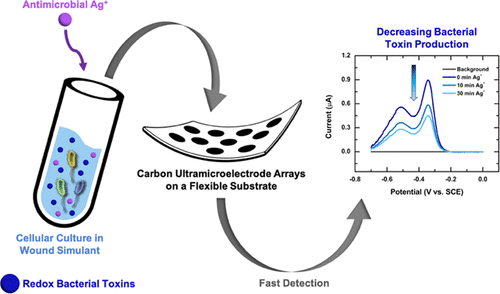Our official English website, www.x-mol.net, welcomes your feedback! (Note: you will need to create a separate account there.)
Electrochemical Detection of Multianalyte Biomarkers in Wound Healing Efficacy
ACS Sensors ( IF 8.9 ) Pub Date : 2020-11-11 , DOI: 10.1021/acssensors.0c01697 Olja Simoska 1 , Jonathon Duay 1 , Keith J. Stevenson 2
ACS Sensors ( IF 8.9 ) Pub Date : 2020-11-11 , DOI: 10.1021/acssensors.0c01697 Olja Simoska 1 , Jonathon Duay 1 , Keith J. Stevenson 2
Affiliation

|
The targeted diagnosis and effective treatments of chronic skin wounds remain a healthcare burden, requiring the development of sensors for real-time monitoring of wound healing activity. Herein, we describe an adaptable method for the fabrication of carbon ultramicroelectrode arrays (CUAs) on flexible substrates with the goal to utilize this sensor as a wearable device to monitor chronic wounds. As a proof-of-concept study, we demonstrate the electrochemical detection of three electroactive analytes as biomarkers for wound healing state in simulated wound media on flexible CUAs. Notably, to follow pathogenic responses, we characterize analytical figures of merit for identification and monitoring of bacterial warfare toxin pyocyanin (PYO) secreted by the opportunistic human pathogen Pseudomonas aeruginosa. We also demonstrate the detection of uric acid (UA) and nitric oxide (NO•), which are signaling molecules indicative of wound healing and immune responses, respectively. The electrochemically determined limit of detection (LOD) and linear dynamic range (LDR) for PYO, UA, and NO• fall within the clinically relevant concentrations. Additionally, we demonstrate the successful use of flexible CUAs for quantitative, electrochemical detection of PYO from P. aeruginosa strains and cellular NO• from immune cells in the wound matrix. Moreover, we present an electrochemical examination of the interaction between PYO and NO•, providing insight into pathogen–host responses. Finally, the effects of the antimicrobial agent, silver (Ag+), on P. aeruginosa PYO production rates are investigated on flexible CUAs. Our electrochemical results show that the addition of Ag+ to P. aeruginosa in wound simulant decreases PYO secretion rates.
中文翻译:

电化学检测伤口愈合功效中的多种分析物生物标志物
慢性皮肤伤口的靶向诊断和有效治疗仍然是医疗保健负担,需要开发用于实时监测伤口愈合活动的传感器。在这里,我们描述了一种在柔性基板上制造碳超微电极阵列(CUA)的适用方法,目的是利用该传感器作为可穿戴设备来监测慢性伤口。作为概念验证研究,我们展示了在柔性CUA上模拟伤口介质中三种生物活性分析物作为伤口愈合状态生物标志物的电化学检测。值得注意的是,为了追踪致病性反应,我们表征了鉴定和监测机会性人类病原体铜绿假单胞菌分泌的细菌战毒素黄体素(PYO)的分析价值。。我们还证明了尿酸(UA)和一氧化氮(NO •)的检测,它们分别是指示伤口愈合和免疫反应的信号分子。电化学测定的PYO,UA和NO •的检出限(LOD)和线性动态范围(LDR)均在临床上相关浓度之内。此外,我们证明了柔性CUAs成功用于定量,电化学检测铜绿假单胞菌菌株中PYO和伤口基质中免疫细胞的细胞NO •的用途。此外,我们提出PYO和NO之间的相互作用的电化学检查•,深入了解病原体-宿主反应。最后,在柔性CUA上研究了抗菌剂银(Ag +)对铜绿假单胞菌PYO生产速率的影响。我们的电化学结果表明,在伤口模拟物中向铜绿假单胞菌添加Ag +会降低PYO的分泌速率。
更新日期:2020-11-25
中文翻译:

电化学检测伤口愈合功效中的多种分析物生物标志物
慢性皮肤伤口的靶向诊断和有效治疗仍然是医疗保健负担,需要开发用于实时监测伤口愈合活动的传感器。在这里,我们描述了一种在柔性基板上制造碳超微电极阵列(CUA)的适用方法,目的是利用该传感器作为可穿戴设备来监测慢性伤口。作为概念验证研究,我们展示了在柔性CUA上模拟伤口介质中三种生物活性分析物作为伤口愈合状态生物标志物的电化学检测。值得注意的是,为了追踪致病性反应,我们表征了鉴定和监测机会性人类病原体铜绿假单胞菌分泌的细菌战毒素黄体素(PYO)的分析价值。。我们还证明了尿酸(UA)和一氧化氮(NO •)的检测,它们分别是指示伤口愈合和免疫反应的信号分子。电化学测定的PYO,UA和NO •的检出限(LOD)和线性动态范围(LDR)均在临床上相关浓度之内。此外,我们证明了柔性CUAs成功用于定量,电化学检测铜绿假单胞菌菌株中PYO和伤口基质中免疫细胞的细胞NO •的用途。此外,我们提出PYO和NO之间的相互作用的电化学检查•,深入了解病原体-宿主反应。最后,在柔性CUA上研究了抗菌剂银(Ag +)对铜绿假单胞菌PYO生产速率的影响。我们的电化学结果表明,在伤口模拟物中向铜绿假单胞菌添加Ag +会降低PYO的分泌速率。


























 京公网安备 11010802027423号
京公网安备 11010802027423号